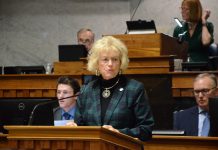
The 2013 legislative session concluded in the early hours of Saturday morning with the state’s $30 billion budget being one of the last bills to pass the General Assembly. Over four months of work went into the production of the budget bill, which ended up passing with bipartisan support. I was pleased to cast my ‘yes’ vote for the balanced budget because of its emphasis on education, job creation and tax reduction.
This session was much different than my first two, as there was an observable effort among the parties to work in a bipartisan manner for the betterment of Indiana. The tone was different, and many of the bills had Democrat and Republican authors and sponsors.
There are many notable success stories from session, including the tax relief package enacted in the budget bill. Hoosiers and their bank accounts will benefit from the $650 million cut from state payrolls per year over the next biennium. The economy has turned around, enabling the Legislature to increase funding for vital services like infrastructure repairs on roads and bridges and education. We’ve funded our priorities to historic levels, while also being able to provide tax relief to struggling Hoosiers.
In looking at the tax cut package, the inheritance tax, commonly referred to as the death tax, has been repealed, enabling more small businesses and family farms to stay in the family. Income taxes will be reduced over the next four years by five percent and corporate income taxes and financial institutions taxes will be lessened to 6.5 percent.
Outside of the budget, I concentrated my efforts on legislation that would directly help Hoosiers in the realm of public health and safety. It’s always great to see a policy initiative that you have been working on for a long time cross the legislative finish line and become law.
A bill I authored, House Enrolled Act (HEA) 1061, allows the judges of the Warrick County circuit and superior courts to jointly appoint a magistrate to help oversee judicial duties. This legislation was authored as a result of efforts to create a position for a magistrate that has been ongoing for almost four years.
According to the 2010 census, the Warrick County population has grown by almost 10,000 people in past ten years, making it one of the fastest growing counties in Indiana. The attractiveness of the region has spurred economic development and consequently, more work for city judges. City judges will be held accountable for their work by the magistrate, creating a higher level of efficiency within the judicial system.
With Warrick County growing so rapidly, it made sense to add a magistrate. The magistrate will have the same essential responsibilities as an elected judge and will ease some of the load in lower level offender cases. The magistrate will be funded by the state, and staff of the county judges will support the magistrate’s duties, meaning no extra costs will be incurred.
I collaborated with my fellow Southwest Indiana legislators to protect our dedicated law enforcement officers by co-authoring HEA 1151, which creates a Blue Alert program for Indiana.
The Blue Alert program will notify the public when a law enforcement officer is killed, seriously injured or missing in the line of duty. The program will be operated by the Indiana State Police Department and will also alert the public if the criminal who caused harm has not been apprehended and may be a danger to others.
This program will help address issues of public safety in our communities. I sincerely hope the Blue Alert program will help ease the minds of the brave men and women who serve our communities.
I also worked with fellow legislators in the Senate. Among these bills was Senate Enrolled Act (SEA) 554, which will save Hoosier taxpayers thousands of dollars each year under telehealth and telemed services.
Patient monitoring can now be done in the home by a health care provider from a distance. Telehealth and telemedicine services allow physicians and psychiatrists to care for their patients without having those patients travel to receive them or having physicians use precious time and money to visit the patients in their homes.
As a healthcare professional, I felt very strongly about the importance of this particular legislation. Specifically for congestive heart failure, there is normally a one in four readmission rate. With telehealth, there is a one in twenty readmission rate. Reducing the readmission rate means that patients are having healthier outcomes, and is less costly.
I am honored to be your voice at the Statehouse. However, I always enjoy coming back home to our community and digging into our local issues. I am appreciative of your communication over the last four months – it is encouraging to hear your thoughts, and it helps me vocalize what is best for Hoosiers.
As always, you can contact me by phone at 317-232-9674 or by email at H75@in.gov. Be on the lookout for more information from me coming in the next couple of months and have a great summer!




